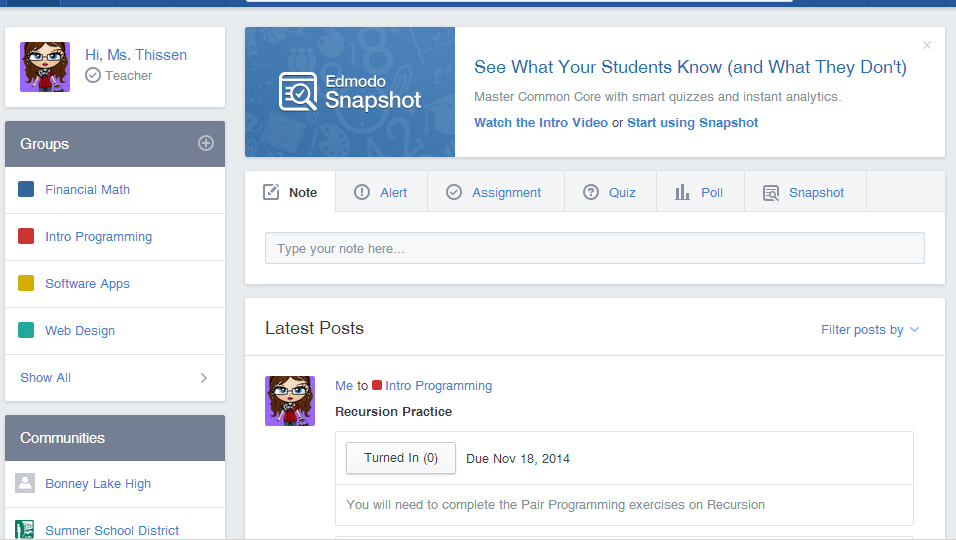
There are several aspects that I considered when researching the International Society for Technology Education (ISTE) Standard I for students. How can I model and promote innovative thinking in my subject area while using technology to facilitate my students learning through communication and collaboration?
In looking through several collaboration tools such as Edmodo, Wikis and Blogs, I found that student preference and experience becomes important. In my classroom students are primarily juniors and seniors, who with all their experiences can be selective when it comes to technology. Most students are familiar with and participate in texting, Facebook, Instagram, YouTube and Snapchat, but there is still a small number that do not share in those experiences because it is not affordable. Any technology I would use needs to be simple to use or familiar and available to all students. It is my belief that if you have to spend more time on teaching how to use the technology then the subject matter, you are using the wrong technology tool.
Other collaborative tools such as Wikis and Blogs are easy to use in the classroom for subject matter, they are controlled by the students and provide a platform for creating knowledge but with the ability to be moderated for appropriate interactions and correct usage. “We as researchers and educators observe students engaging in formal, informal, and nonformal learning across a wide range of contexts and exercising considerable authority over how, when, and with whom they learn” (Greenhow, Roblia, & Hughes, p. 248). For older students who are technology savvy Wikis work, and Blogs are ideal for students to reflect on their learning.
One of the advantages of Web 2.0 social networking, is that through participation students value and understand digital citizenship skills (Greenhow, Roblia, & Hughes, pg 251). Edmodo is known as the “Facebook for Schools”, it has the appearance and interaction of Facebook, so students are familiar with how to create and use their digital identity.
http://www.youtube.com/watch?v=mo1t-OZLJbI
The tool allows for student reflection and the collaboration, making it easy to find and correct a student’s concept misunderstandings through appropriate and defined reflection prompts. There are a couple teachers in my building, who teaching the same subject matter and use Edmodo to create an even larger community, allowing for a greater level of diversity. The teachers collectively facilitate experiences that advance student learning, by also collaborating and communicating with each other and each other’s students. While this is successful, it has not transferred into our teacher training practices.
Our grade-level counselors attempted to use the platform to help teachers with questions on curriculum and student work. The use of Edmodo as this type of training didn’t translate into the need for a collaborative environment and was not used. But the idea of this type of social networking being used in teacher training is promising. By using the technology in the training of teachers you are preparing/modeling for teachers how to use the technology with students.
 I have in the past taken some time to experiment with Edmoto, I created my account several years ago as our district maintains an Edmoto domain in which we have access organized by each school. Our first class project for students using Edmoto, was to create a class that included all students within grade level advisories. There were students quick to use the site for the required documents and ask questions of content requirements. Those students who were brave enough to ask questions were more aware of their posts which were fairly simplistic responses and questions. This is both good and bad, as one of my colleagues stated she “was also very happy to see the part about students interacting while requiring proper usage/grammar”, in this case most students’ self-monitored to the point of not posting.
I have in the past taken some time to experiment with Edmoto, I created my account several years ago as our district maintains an Edmoto domain in which we have access organized by each school. Our first class project for students using Edmoto, was to create a class that included all students within grade level advisories. There were students quick to use the site for the required documents and ask questions of content requirements. Those students who were brave enough to ask questions were more aware of their posts which were fairly simplistic responses and questions. This is both good and bad, as one of my colleagues stated she “was also very happy to see the part about students interacting while requiring proper usage/grammar”, in this case most students’ self-monitored to the point of not posting.
The possibility for learning, collaborating and communicating is an integral part of Edmoto, so why didn’t it work for our school and myself? Two reasons why this failed and why I gave up on my attempts to integrate my curriculum, at this time.
First, the concept of creating a place for all grade level advisories sounds great, but the idea of having a “class” population of over 300 students was not well received, primarily because of the large number of students. If you think about the fact that they probably have over 300 “friends” in their Facebook accounts, the difference was that they had control of who they accepted. They were less apt to contribute or participate in view of the entire student grade level, when peers that they didn’t associate with or chose not to associate with were part of the advisory.
Secondly, in order for this to work seamlessly, all students needed access. Common sentiment by myself and other teachers trying to integrate Edmoto was that we needed a one-to-one environment to make this work well. I already have a website that contains my curriculum and the idea of loading everything into a system that wasn’t working as well as we thought it could be daunting. As it looks now, we should be one-to-one by 2017, and I know Edmoto as well as Google Classroom will again be at the forefront of the conversation, with new tools and applications. Aa an added bonus this application addresses multiple criteria, including communications and student engagement, in the new state teacher evaluations.
Greenhow, C., Roblia, B., & Huges, J.E. (2009). Teaching, and Scholarship in a Digital Age Web 2.0 and Classroom Research: What Path Should We Take Now? Educational Researcher 38 (4), 246-259
ISTE. (2008). National educational technology standards for teachers: Preparing teachers to use technology. ISTE (International Society for Technology in Education).
Hi there,
Great post! I really connected when you wrote “Any technology I would use needs to be simple to use or familiar and available to all students. It is my belief that if you have to spend more time on teaching how to use the technology than the subject matter, you are using the wrong technology tool.” We have limited resources, as I’m sure is the case with most schools, and limited time to cover a huge amount of content. It’s hard to justify taking up precious class time to teach the vehicle for the actual learning topic.
Your use of Edmodo sounds enriching, and seems like a fun way to collaborate. I’m curious if it would work well for cross-curricular PLC groups. But with this, like you mentioned, comes the need for training and modeling. What seems to be hard for my colleagues (myself included) is the idea of not being an expert on something in the classroom. And like the students, the more we familiarize ourselves with the tech, see it used and modeled, the more accessible it will become. Maybe after this course, the people modeling the use of tech tools will be us. Exciting!
You’ve given me a lot to think about. Thanks.
Sara